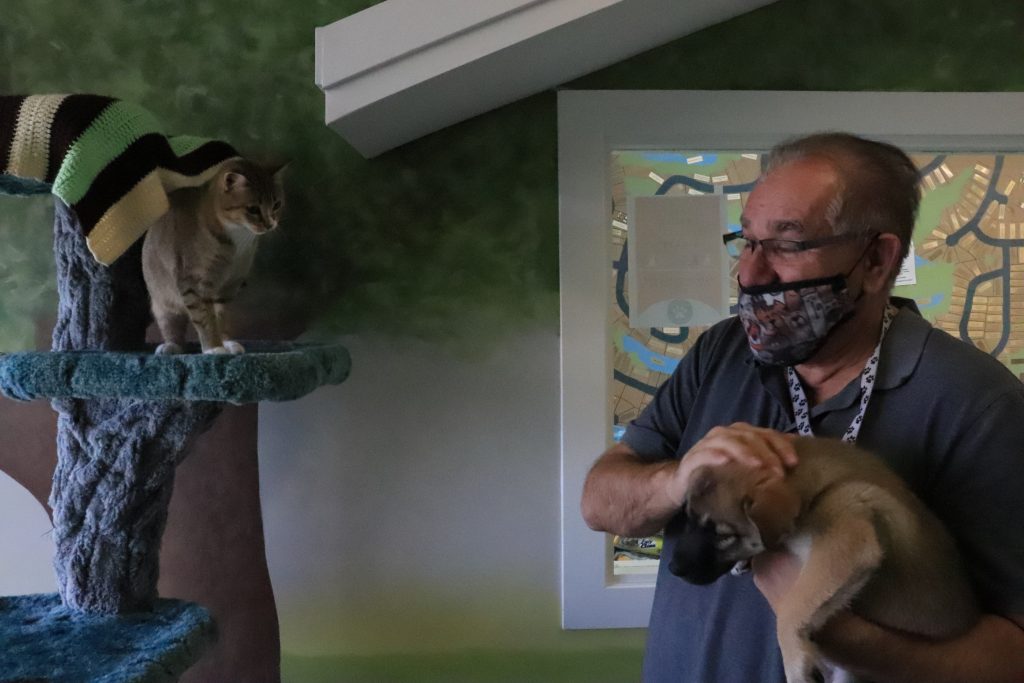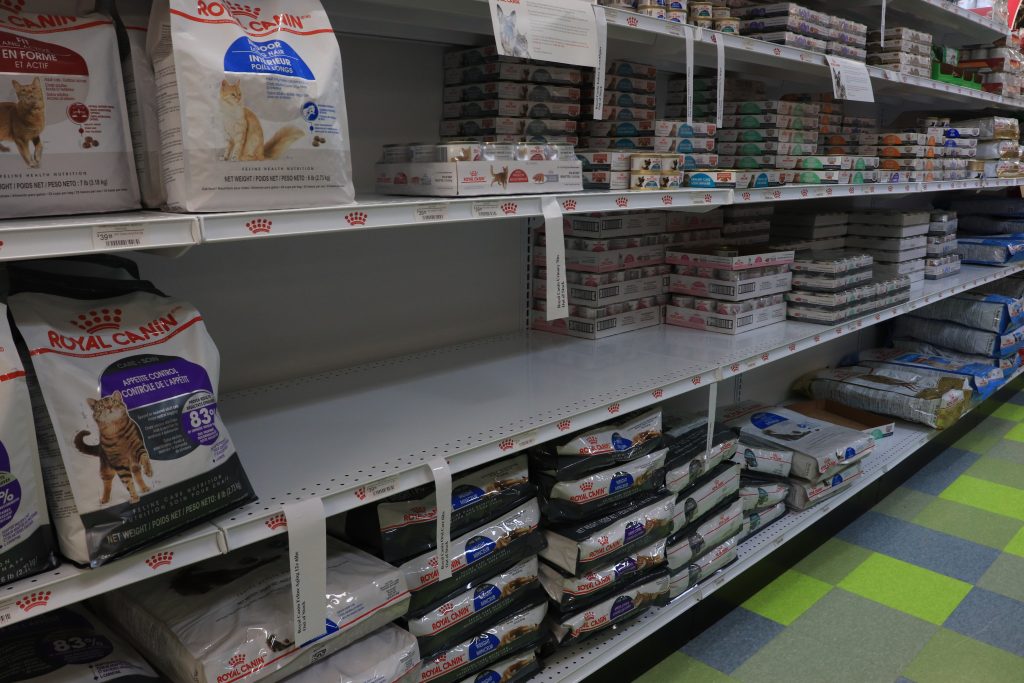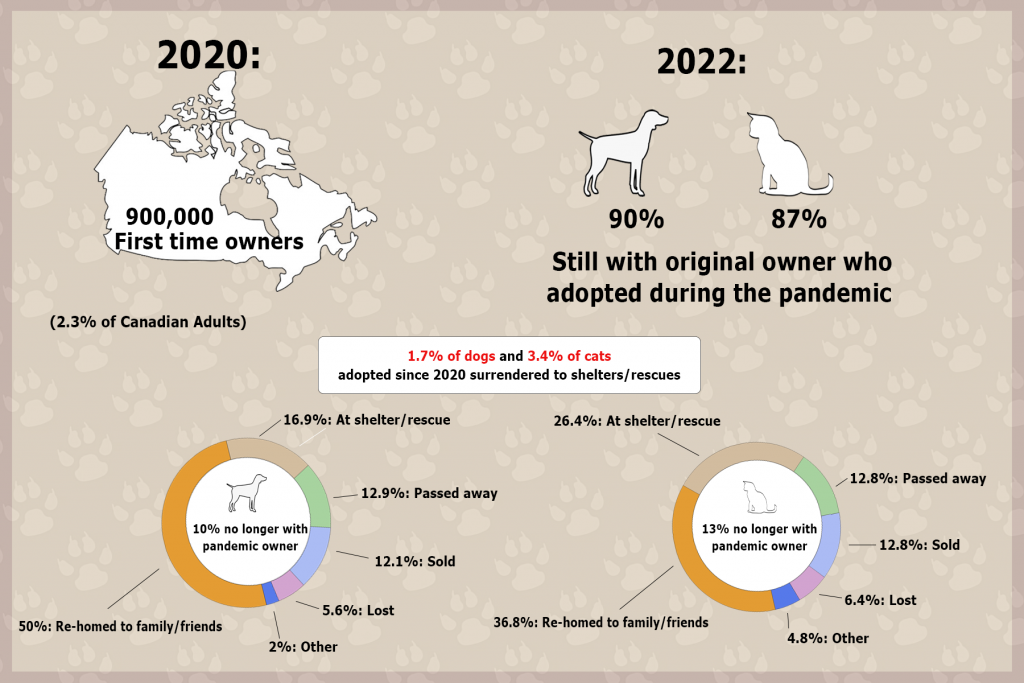Listen to the story:
On a Saturday morning in September 2020, I was abruptly woken up by my mom: “Get up. We’re getting a cat.”
After searching around the city, we brought Korra home the next day. I became one of the approximately 900,000 Canadian adults to be a first-time pet owner during the COVID-19 pandemic. Being locked down at home meant more time to care for a new companion or two. Many of us who’d always wanted pets felt this was the perfect time to finally bring one home.

According to Google Trends data, interest in adopting a cat or dog peaked in April and May of 2020. Google searches relating to pet adoption increased by up to 250 per cent during these months. In shelters and rescues, pens and kennels were quickly being emptied.
“People came and got all the animals. My goal was to shut down the shelter because there’s no more homeless animals in the city of Winnipeg. I felt that last year. I thought ‘oh my God, are we no longer in business?’” said D’Arcy Johnston, founder of D’Arcy’s Animal Rescue.
Many people, including myself, can vouch for how our pets have helped us during the pandemic. Over 80 per cent of Canadian pet owners say their pets have helped them relieve stress over the past two years.
But for people who work with animals, the increase in ownership has largely had the opposite effect. Things that were issues before the pandemic have now been magnified by a variety of factors. These include supply issues, an overload of clients, pets that haven’t been properly socialized, and an increase in pet abandonment. Cracks have been revealed and workers have been pushed to the extreme.
While animal shelters across Canada were emptied early in the pandemic, many found themselves back at full capacity a few months later. A rise in surrenders and strays have left many shelters and rescues either at or above capacity limits.
With more people adopting animals, where are these surrenders and strays coming from? The answer is complicated. Many Canadians have lost money during the past two years for reasons like long-term unemployment and economic recession. Owners may surrender their pet if they believe they can’t properly care for them anymore. In Prince Edward Island, higher eviction rates resulted in more surrendered pets going to rescue shelters.
Running an animal shelter or rescue is often costly. Each animal must be properly cared for. This includes treating medical issues and providing food, water, and toys. According to business advice website Costhack.com, an average sized shelter that houses between 30 to 60 animals can expect to spend between $10,000 to $15,000 annually on these expenses. Constantly being at full capacity means more money is being spent to care for these animals.
While expenses are up, the amount of money coming in is not. A key part of a rescue shelter’s income usually comes from donations. Tough economic times means that donations are down.
“I understand that too, because I want to make sure that if anything happens, I have money to feed my family and pay my bills too,” Johnston said.
“People are giving less right now, and it’s hurting.”

Restrictions on physical gatherings during the pandemic have made it harder for rescue shelters to run the fundraising programs and events that get people to donate. Many organizations had to switch to online fundraising.
“We [usually] do in-person adoption events and all that kind of stuff, but that all had to be pivoted,” said Lindsay Gillanders, media relations for Manitoba Underdogs Rescue.
“It was our tenth anniversary last summer and we really wanted to have a big celebration and then obviously that wasn’t able to happen either.”
In January, animal rescue organizations across Canada saw a sudden spike in donations. The motivation behind this came from an unexpected source: Betty White’s death.
Following the actresses’ passing on Dec. 31, 2021, a call to action spread across social media in Canada and the United States. The “Betty White Challenge” raised over half a million dollars for rescue shelters in Canada on Jan. 17, 2022.
January is usually the toughest time of the year for charity organizations. People generally spend and donate less money following the holidays. The spike in donations gave these organizations some relief during a tough time.
Another source of relief for rescue shelters has been the increase in people fostering animals. Foster home applications increased by 17 per cent in 2020. Foster homes free up space and reduce the workload for shelters that are near or at capacity limits.
Being at a shelter is a stressful experience for animals. They often need medical care while in a strange new environment. Territorial animals like cats tend to become anxious when they’re surrounded by animals that they’re unfamiliar with. Being in a foster home gives pets the opportunity to relax in a secure environment.
Jade Ferens is one of the many new fosterers in Winnipeg. His living situation would make adopting a pet complicated, so fostering is a perfect compromise to have a cat in the house.
Higher foster rates have positively affected shelters. Many animals end up being adopted into permanent homes once the fostering period has ended.
“To my knowledge, every single one has gone on to be adopted,” Ferens said.
Fostering is a less expensive alternative to adopting, as many larger shelters have programs to provide fosterers with the supplies they need.
“We go through the [Winnipeg] Humane Society, and they actually supply everything that we need. There’s the odd time where I’ll go out and get food, but it either costs me nothing or a lot less than it would to own a cat,” Ferens said.
Even with the financial ups and downs that shelters and owners are facing, there is another larger problem that money can’t solve: the lack of pet food on the shelves.
The rise in pet ownership has driven demand for pet food higher than pre-pandemic levels. According to Statista.com, worldwide revenue from pet food sales increased by 9.2 per cent in 2020, reaching $102.6 billion (USD).
But supply hasn’t been able to keep up with demand. There’s currently a global supply shortage of canned cat and dog food. A major reason is manufacturing issues like a shortage of aluminum cans.
“Our food is down 80 per cent. It’s just not in stock,” Johnston said.
“We’re being told it’s not going to be until maybe next year until we get our normal supply. Not even a definite date, just maybe next year.”

This has made it hard for owners like me who have picky pets that only eat certain types of food. But it has also made it harder for owners whose pets need special diets to find the proper food they need. Abruptly changing a dog’s diet without a transition period can lead to health problems, including vomiting, diarrhea and a decreased appetite.
Problems like this can result in an animal needing to pay a visit to the vet. But just like the shortage in food, veterinarians are having their own problems when it comes to shortages.
“Unfortunately, veterinarian medicine gets the short end of the stick when it comes to supplies,” said Kayla Noel, practice manager and registered veterinary technologist of the Sage Creek Animal Hospital.
“If there ever is a shortage in human medicine, they first pull it from veterinary medicine and don’t let us have access to it so they can prioritize human health. It makes sense, but it’s still very difficult for us.”
Vets have faced a shortage of propofol, a drug used for anesthesia when preparing both people and animals for surgery. In March 2021, it was given an emergency use authorization by the United States Food and Drug Administration. It is now crucial in treating COVID-19 patients who require intensive care. The drug keeps critically ill patients in a sedated, coma-like state.
Availability of other medical supplies such as gloves and masks have also fluctuated for vets. Just like medicine, these supplies are prioritized for human needs first.
Perhaps the worst shortage to hit the industry is the lack of vets. Vet shortages have become a problem across Canada as more are now leaving the field than graduating into it. Only one of the five accredited veterinary schools in Canada has increased its seats recently according to Dr. Louis Kwantes, the president of the Canadian Veterinary Medical Association.
This was already an issue before the pandemic, but burnout related to COVID-19 has accelerated the problem. More people owning pets means that vets are busier than ever due to more appointments.
Vets have had to take on a higher workload even with their workplaces being short-staffed. Many animal hospitals and clinics have switched to what is called a “closed door policy.” Due to safety concerns about COVID-19, these hospitals now do many of the screening questions over the phone.

The Sage Creek Animal Hospital is one of the many in Canada that adopted this practice. When I took Korra there for her first checkup, I was required to hand her over to the vet at the door. The checkup was done while I waited outside the building, communicating with hospital staff over the phone.
“It takes a lot more staff because you now need staff to hold those pets, you need staff to be talking on the phone,” Noel said.
“Our staffing takes a lot more work, and it ended up burning out a lot of people because there’s just too much work and too many grumpy people.”
Due to the increase in pet ownership, demands for vet appointments have increased. However, the time appointments take has also increased because of the new safety procedures. This has led to appointments being rescheduled or postponed and more abuse being directed at vets.
Vets have reported higher rates of abuse from pet owners during the pandemic. A pet is usually seen as a beloved family member. If they need medical attention, it often leads to stress for the owner. Add this to the anxiety of living during a pandemic, and you have a scenario where people aren’t shy to vent their frustrations.
“Here in Manitoba, we don’t get to see the prices of human medical care due to the public health system. But on the veterinary side, we’re constantly being told that we’re gauging clients when all we’re trying to do is recommend what’s best for a pet’s health,” said Noel.
Being repeatedly subjected to verbal abuse takes a toll, especially for those newer to the field.
“COVID sucks for everyone, but when you take it out on other people, that can hurt mindsets and confidence levels and that can cause people to burn out,” Noel said.
With many owners having to work from home, they are spending more time around their pets. This is another reason why bookings for checkups have gone up.
“When people are spending more time at home, they’re noticing problems more frequently than when they’re out in the office all day and only seeing their pet for an hour or two in the evening,” Noel said.
This may raise eyebrows about owners being overly worried and bringing pets in for false alarms, but in most cases, the concerns of owners have merit.
“Things like arthritis, a lot of people weren’t noticing it before. Then suddenly we get this giant spike of arthritis,” Noel said.
“It’s because they weren’t home or around watching their pet during the day to see it slowing down or limping and sleeping all day.”
While all this time with pets has been useful for catching potential illnesses, animal professionals have reported that more pets have shown signs of behavioural issues during the pandemic. The most common of these is aggressiveness caused by separation anxiety from their owner.
The early stages of a puppy’s life are crucial for being socialized. Failure to do this properly can results in long-term consequences for both them and their owners.
“I think every trainer and daycare has seen a rise in what we’re calling ‘COVID puppies,’” said Celeste Bennett, general manager of the Happy Tails Pet Resort & Spa.
“They’ve been a lot more difficult to handle than puppies that have been previously adopted. Because people are staying home with their pets more frequently, they’re just not getting as well adjusted like other dogs were before.”
The number of dogs being brought to animal day cares has increased. Just like with vets, more owners means that more people need services like these. But during the initial lockdown in early 2020, use of the services declined.
“When the pandemic first started in March, we went from around one hundred dogs a day to ten dogs a day overnight with all the shutdowns,” Bennett said.
When restrictions lifted during the summer, many new owners needed somewhere for their pets to go during the workday. Easing of travel restrictions also meant that many traveling owners needed somewhere for their pet to stay. The daycare saw its numbers rise back to capacity following the easing of restrictions.
When restrictions came back into place due to the Omicron variant, it would be reasonable to expect services like these would decrease in use again. But this wasn’t the case.
“I think that people now are learning to adjust their lifestyles around COVID, so they’re getting into the routine that even if they’re working from home, they’re taking their dogs back to daycare,” Bennett said.
Owners have generally been able to learn and adapt as the pandemic has gone on. People like me who became first-time owners in 2020 will have now had our pets for at least a year.
During the summer of 2021, there were fears that a “wave of abandonment” would arrive once the pandemic ended and people returned to normal life. While it’s still a far cry to say the pandemic is over (or even close to being over), it would be wrong to point fingers at people who adopted during the pandemic for the high surrender rates.
According to a study done by the journal Frontiers in Veterinary Science, 90 per cent of dogs and 87 per cent of cats acquired during the pandemic are still with their owners. Of those who are no longer with their owners, only 17 per cent of dogs and 26 per cent of cats were surrendered to shelters or rescues. This comes to only 1.7 per cent of dogs and 3.4 per cent of cats who were acquired over the pandemic being surrendered.

The majority of pets adopted during the beginning of the pandemic are still with their owners. / JOËL LIZOTTE
The idea that someone who adopted during the pandemic will get bored of their new pet and surrender to a shelter is simply not true. Surrendering a pet is usually a last resort when an owner is in a crisis. Whether this is financial or health related, it can cause owners to believe that they have no other options.
For us new owners, our pets have helped us cope emotionally during a very strange and difficult time. In a time where my usual perception of days and months has gone up in flames, caring for a pet helped keep me grounded. Korra has given me a daily routine, and more importantly, a reason to finally crawl out of bed in the morning. On rare occasions when I left the house during the height of the pandemic, I could be sure that she would be there to greet me at the door when I got back.
But just as being a responsible pet owner involves caring for our four-legged companions, it also involves being aware of what animal professionals have gone through and making an effort not to make their lives harder.
If you or somebody you know is considering surrendering a pet, there are ways to find your pet a better home without increasing the strain rescues and shelters are already facing. Friends, family, and neighbours are a good place to start. If you’re somebody who isn’t able to adopt an animal, consider applying to be a foster home, or donating to a local shelter.
